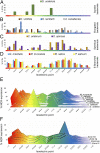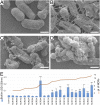Morphotype of bacteroids in different legumes correlates with the number and type of symbiotic NCR peptides
- PMID: 28438996
- PMCID: PMC5441718
- DOI: 10.1073/pnas.1704217114
Morphotype of bacteroids in different legumes correlates with the number and type of symbiotic NCR peptides
Abstract
In legume nodules, rhizobia differentiate into nitrogen-fixing forms called bacteroids, which are enclosed by a plant membrane in an organelle-like structure called the symbiosome. In the Inverted Repeat-Lacking Clade (IRLC) of legumes, this differentiation is terminal due to irreversible loss of cell division ability and is associated with genome amplification and different morphologies of the bacteroids that can be swollen, elongated, spherical, and elongated-branched, depending on the host plant. In Medicago truncatula, this process is orchestrated by nodule-specific cysteine-rich peptides (NCRs) delivered into developing bacteroids. Here, we identified the predicted NCR proteins in 10 legumes representing different subclades of the IRLC with distinct bacteroid morphotypes. Analysis of their expression and predicted sequences establishes correlations between the composition of the NCR family and the morphotypes of bacteroids. Although NCRs have a single origin, their evolution has followed different routes in individual lineages, and enrichment and diversification of cationic peptides has resulted in the ability to impose major morphological changes on the endosymbionts. The wide range of effects provoked by NCRs such as cell enlargement, membrane alterations and permeabilization, and biofilm and vesicle formation is dependent on the amino acid composition and charge of the peptides. These effects are strongly influenced by the rhizobial surface polysaccharides that affect NCR-induced differentiation and survival of rhizobia in nodule cells.
Keywords: legume; nitrogen-fixing bacteroids; nodule; nodule-specific cysteine-rich peptides; symbiosis.
Conflict of interest statement
The authors declare no conflict of interest.
Figures




References
-
- Alunni B, et al. Genomic organization and evolutionary insights on GRP and NCR genes, two large nodule-specific gene families in Medicago truncatula. Mol Plant Microbe Interact. 2007;20:1138–1148. - PubMed
-
- Bonaldi K, et al. Nodulation of Aeschynomene afraspera and A. indica by photosynthetic Bradyrhizobium Sp. strain ORS285: The nod-dependent versus the nod-independent symbiotic interaction. Mol Plant Microbe Interact. 2011;24:1359–1371. - PubMed
Publication types
MeSH terms
Substances
LinkOut - more resources
Full Text Sources
Other Literature Sources

